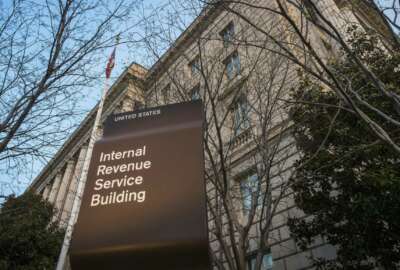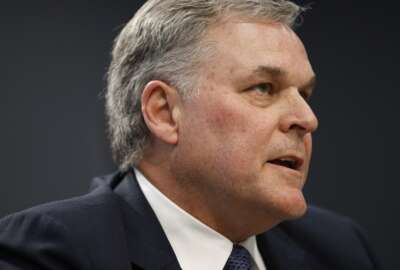
Hubbard Radio Washington DC, LLC. All rights reserved. This website is not intended for users located within the European Economic Area.
Hubbard Radio Washington DC, LLC. All rights reserved. This website is not intended for users located within the European Economic Area.
The IRS estimates it will need $4 billion in multi-year funding over the next five years to meet the goals of the 2019 Taxpayer First Act and its IT modernizati...
The IRS, in addition to sending millions of pandemic stimulus payments and preparing for the start of the tax filing season, has spent much of the new year gearing up for its most significant reorganization in recent years.
That shakeup doesn’t have anything to do with the start of the Biden administration — at least not yet. Rather, the IRS has laid the groundwork to implement the 2019 Taxpayer First Act.
The IRS, in compliance with the law, recently sent Congress an in-depth report outlining strategies to overhaul the way it approaches taxpayer experience and employee training. The IRS is also naming a chief customer experience officer and has submitted an agency reorganization plan.
A six-year IT modernization plan that began in 2019 underpins much of the agency’s success in meeting the goals of the Taxpayer First Act.
Success, however, won’t come cheap. The IRS, in its report to Congress, estimates it will need $4 billion in multi-year funding over the next five years to meet the goals of the legislation and its IT modernization plan.
“This is an aspirational vision that builds on work that is already underway and provides an investment framework for evaluating IRS funding levels in future years,” the IRS wrote. “However, without the commitment of significant multi-year funding, the IRS cannot make the taxpayer improvements necessary to maintain trust and confidence in the federal government and its tax collection system.”
Congress gave the IRS $43 million in the $1.4 trillion omnibus package it approved in December, but lawmakers remain wary of giving the agency the level of funding it’s asking for.
Former National Taxpayer Advocate Nina Olson, now the executive director of New America’s Center for Taxpayer Rights, said conversations about IT funding with appropriations committees and congressional staff would, during her tenure, invariably turn to the IRS’ last major effort in the 1990s — a project that fell short of expectations.
“When you’d talk about it, they’d say, ‘Yeah, but we gave them money, and they blew it.’ It’s still fresh in people’s minds, even though it was decades ago,” Olson said.
The Taxpayer First Act, she said, has addressed those congressional concerns by requiring the IRS to develop strategies to improve customer satisfaction, employee training and modernize its legacy systems.
“Now Congress has a chance to look at that and say, ‘This gives us confidence, or actually it doesn’t give us confidence. We need more detail, or we don’t think you’ve articulated a clear enough vision or a visionary enough vision. This is not good enough for the taxpayers of the United States.’ But at least they’ve got something now that they can react to, and then appropriate accordingly,” Olson said.
Lawmakers, meanwhile, could call on the Government Accountability Office, the Treasury Inspector General for Tax Administration or a third-party auditor to give additional oversight to ensure multi-year funds are spent wisely — even if Congress doesn’t immediately see results in the early stages of the modernization.
Tony Reardon, president of the National Treasury Employees Union President, said the union will encourage Congress to provide sufficient funding to implement the legislation. NTEU recently submitted a report to the IRS outlining some of the top priorities for reform.
Reardon said IRS officials NTEU has spoken with have expressed an interest in reinvesting in agency training — a budget item that Reardon said has fallen by about 85% since 2013.
Aside from training, Reardon said the legislation would reinvigorate the IRS workforce by breaking down some of the silos between its business operating divisions.
“If it is done properly, what it will do ultimately is it will provide employees more opportunity for career growth. It will provide a more seamless ability to move from one division to another,” Reardon said
IRS Commissioner Chuck Rettig, whose term as commissioner ends in 2022, has also spoken with Reardon about the opportunity the Taxpayer First Act has given the agency.
“He agrees that it’s one thing to, at a high level, talk about collaborating and communicating about these issues. But now we move into a process of actually sitting down and working on specific issues, and he has indicated a willingness and a hope to do that,” Reardon said, recalling his recent conversation with Rettig.
The IRS reorganization also comes with an emphasis on improving taxpayer service. Olson said she was encouraged to see that the Taxpayer First Act would require the IRS to name a chief customer experience officer and would restructure the agency in such a way that would focus the agency as much on taxpayer experience as enforcement.
“It seems bifurcated in a way — you’ve got service over here, and then you’ve got enforcement over there. And I would really like to see people think holistically, it’s part of your job every day to provide customer service, even as you’re going about trying to bring about compliance,” Olson said.
Overhauling the way the IRS delivers services, however, depends on how it succeeds in its IT modernization effort.
The agency’s new Enterprise Digitalization and Case Management Office made promising steps last year when it began migrating business processes from legacy systems and onto a cloud-based enterprise case management system.
That migration, Olson said, will help the agency achieve a “360-degree view of the taxpayer’s experience” and interactions with the IRS. The agency’s current IT infrastructure includes 60 legacy systems that provide some information about a taxpayer’s history with the IRS, but not the whole picture.
“It’s sort of like a kaleidoscope. All those little bits and pieces of glass, they’re all little bits and pieces of information. When you look through the kaleidoscope, you see one pattern, but if you just turn it a tiny little fraction along the dial, all those pieces of glass fall into a different way, and it will give you a different picture of that taxpayer and the IRS is operating somewhat blind, because it can’t see all that information,” Olson said.
For all of the agency’s focus on digital services, the National Taxpayer Advocate’s recent report to Congress has highlighted its perennial struggle with staffing call centers to meet its volume of calls.
IRS personnel answered only 24% of taxpayer calls during fiscal 2020, and callers waited on hold for an average of 18 minutes.
While the IRS is borrowing some of what has worked in private industry to improve customer experience, Olson said the stakes of a taxpayer not getting help from the agency are much higher.
“The IRS is not like an airline, it’s not like ordering on Amazon. If you get a notice from the IRS, you may not want to talk to the IRS, but you need to talk to the IRS. You’re not comfortable leaving it to some chat that you might get the correct answer, because if you don’t really connect with a human being and make sure they’re entering the right information into the system, bad things could really happen to you,” she said.
The IRS IT modernization strategy also depends on multi-year funding the agency has asked of Congress, but has yet to receive.
Congress may balk at the scope of what the IRS is asking, but the costs of maintaining legacy IT — and hiring staff who can work with outdated programming languages — already put a drain on the agency’s limited IT budget.
“It will be long and it will not be cheap, and every day that goes by it gets increasingly expensive,” said Chad Hooper, the executive director of the Professional Managers Association.
Former IRS Chief Technology Officer Terry Milholland said that in for an agency starved for resources, the IRS IT office has especially been forced to do more with less, but can’t keep going on this way.
Under the status quo, Milholland said “everyone will muddle through dealing with the day-to-day problems and sort of just move forward as best they can.”
The IRS, meanwhile, is taking steps to address its shrinking workforce. The agency doubled in hiring in fiscal 2020 — making more than 12,000 external hires and 11,000 internal hires.
The IRS is also working with the Treasury Department to pilot a hiring system that, according to its year-end report, “has the potential to revolutionize hiring across the agency, improve the customer experience and enhance other reporting capabilities.”
While these are promising signs for an agency that lost more than 33,000 full-time employees since 2010, Olson said the agency should gradually build up its workforce and training.
“What the IRS really needs is incremental increases from one year to the next over a period of years to get itself to be able to absorb those employees, train them well and then move to the next batch of employees. You don’t want it to be feast and famine, because that just never works,” Olson said.
Copyright © 2024 Federal News Network. All rights reserved. This website is not intended for users located within the European Economic Area.
Jory Heckman is a reporter at Federal News Network covering U.S. Postal Service, IRS, big data and technology issues.
Follow @jheckmanWFED

